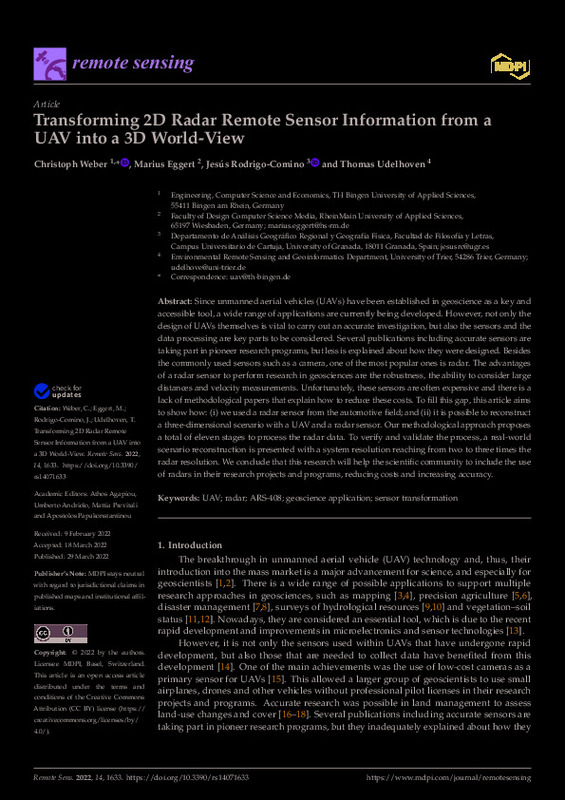JavaScript is disabled for your browser. Some features of this site may not work without it.
Buscar en RiuNet
Listar
Mi cuenta
Estadísticas
Ayuda RiuNet
Admin. UPV
Transforming 2D Radar Remote Sensor Information from a UAV into a 3D World-View
Mostrar el registro sencillo del ítem
Ficheros en el ítem
| dc.contributor.author | Weber, Christoph
|
es_ES |
| dc.contributor.author | Eggert, Marius
|
es_ES |
| dc.contributor.author | Rodrigo-Comino, Jesús
|
es_ES |
| dc.contributor.author | Udelhoven, Thomas
|
es_ES |
| dc.date.accessioned | 2024-04-11T11:58:49Z | |
| dc.date.available | 2024-04-11T11:58:49Z | |
| dc.date.issued | 2022-04 | es_ES |
| dc.identifier.issn | 2072-4292 | es_ES |
| dc.identifier.uri | http://hdl.handle.net/10251/203431 | |
| dc.description.abstract | [EN] Since unmanned aerial vehicles (UAVs) have been established in geoscience as a key and accessible tool, a wide range of applications are currently being developed. However, not only the design of UAVs themselves is vital to carry out an accurate investigation, but also the sensors and the data processing are key parts to be considered. Several publications including accurate sensors are taking part in pioneer research programs, but less is explained about how they were designed. Besides the commonly used sensors such as a camera, one of the most popular ones is radar. The advantages of a radar sensor to perform research in geosciences are the robustness, the ability to consider large distances and velocity measurements. Unfortunately, these sensors are often expensive and there is a lack of methodological papers that explain how to reduce these costs. To fill this gap, this article aims to show how: (i) we used a radar sensor from the automotive field; and (ii) it is possible to reconstruct a three-dimensional scenario with a UAV and a radar sensor. Our methodological approach proposes a total of eleven stages to process the radar data. To verify and validate the process, a real-world scenario reconstruction is presented with a system resolution reaching from two to three times the radar resolution. We conclude that this research will help the scientific community to include the use of radars in their research projects and programs, reducing costs and increasing accuracy. | es_ES |
| dc.description.sponsorship | This research work was supported by the "European Regional Development Fund" (EFRE) in the context of the aim of "Investment in Growth and Employment" (IWB) in Rhineland-Palatinate, Germany. | es_ES |
| dc.language | Inglés | es_ES |
| dc.publisher | MDPI AG | es_ES |
| dc.relation.ispartof | Remote Sensing | es_ES |
| dc.rights | Reconocimiento (by) | es_ES |
| dc.subject | UAV | es_ES |
| dc.subject | Radar | es_ES |
| dc.subject | ARS-408 | es_ES |
| dc.subject | Geoscience application | es_ES |
| dc.subject | Sensor transformation | es_ES |
| dc.title | Transforming 2D Radar Remote Sensor Information from a UAV into a 3D World-View | es_ES |
| dc.type | Artículo | es_ES |
| dc.identifier.doi | 10.3390/rs14071633 | es_ES |
| dc.rights.accessRights | Abierto | es_ES |
| dc.description.bibliographicCitation | Weber, C.; Eggert, M.; Rodrigo-Comino, J.; Udelhoven, T. (2022). Transforming 2D Radar Remote Sensor Information from a UAV into a 3D World-View. Remote Sensing. 14(7). https://doi.org/10.3390/rs14071633 | es_ES |
| dc.description.accrualMethod | S | es_ES |
| dc.relation.publisherversion | https://doi.org/10.3390/rs14071633 | es_ES |
| dc.type.version | info:eu-repo/semantics/publishedVersion | es_ES |
| dc.description.volume | 14 | es_ES |
| dc.description.issue | 7 | es_ES |
| dc.relation.pasarela | S\460798 | es_ES |
| dc.contributor.funder | European Regional Development Fund | es_ES |








